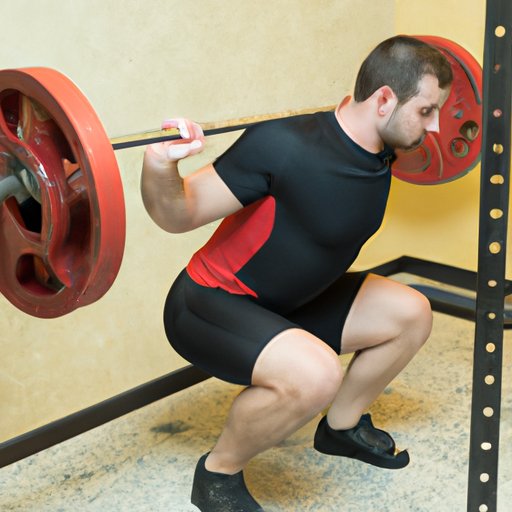
Introduction
Learning how to do barbell rows can be a daunting task, especially for beginners. Proper form and technique are essential to avoid the risk of injury and to maximize the benefits of this exercise. This article aims to provide a step-by-step guide to mastering barbell rows, as well as exploring the benefits of having a strong back and the different variations of this exercise.
A Step-by-Step Guide to Mastering Barbell Rows
Barbell rows are a compound exercise that primarily targets the upper back muscles, but also engage the biceps, shoulders, and lower back. Here is a step-by-step guide on how to perform barbell rows:
- Start by standing with your feet shoulder-width apart, and your shins touching the bar. Keep your spine in a neutral position, and engage your core.
- Grab the bar with an overhand grip, with your hands slightly wider than shoulder-width apart. Make sure your grip is secure and use a mixed grip if needed.
- Lift the bar off the floor, keeping your back straight and your chest up. Your hips should be slightly higher than your knees.
- Begin the row by pulling the bar towards your ribs, keeping your elbows close to your body. Focus on using your back muscles to pull the weight rather than relying on your biceps.
- Pause at the top of the movement and squeeze your shoulder blades together to maximize the contraction in your back muscles.
- Lower the bar back down to the starting position in a controlled manner, keeping your back straight and your chest up.
- Repeat for the desired number of repetitions.
Remember to start with a weight that you feel comfortable with and gradually increase it as you get stronger and more comfortable with your form. It’s better to start light and build up slowly than to risk injury by lifting too much too soon.
For beginners, it can be helpful to use a mirror to check your form and make sure you’re keeping your back straight and your elbows close to your body. A trainer or experienced lifter can also provide feedback and help you refine your technique.
Why Strong Back Muscles Matter
Having a strong back is key to maintaining proper posture and reducing the risk of injury in daily activities. A strong back can also improve athletic performance, such as in sports that require a lot of pulling or lifting.
Barbell rows are an effective exercise for developing a strong back, as it targets the lats, traps, and rhomboids. By strengthening these muscles, you can improve your posture, reduce the risk of back pain, and increase your overall strength.
Barbell Rows vs. Alternatives
There are many alternatives to barbell rows, including seated rows, pull-ups, and chin-ups. Each exercise targets different muscles and can be used to complement each other in a comprehensive training program.
Seated rows, for example, target the mid-back muscles and can be beneficial for those with back pain or limited mobility. Pull-ups and chin-ups, on the other hand, primarily target the lats, but also engage the biceps and shoulders. These exercises can be challenging, especially for beginners, but are highly effective for building upper body strength.
While barbell rows are often seen as an essential exercise for developing a strong back, it’s important to remember that there is no “one-size-fits-all” approach to fitness. Experimenting with different exercises and finding what works best for your body is key to achieving your goals.
The Benefits of Variations
Adding variations to your training program can prevent boredom and help you continue making progress. Here are a few variations of barbell rows that you can try:
- Pendlay Rows: This variation involves starting from a dead stop on the ground after each repetition, which can help improve explosive power.
- T-Bar Rows: This exercise uses a T-bar machine and allows for a closer grip, which places more emphasis on the upper back muscles.
- Single Arm Dumbbell Rows: This exercise is a unilateral movement that allows you to focus on each side of the back separately, helping you identify any imbalances or weaknesses.
By incorporating these variations into your training program, you can challenge your muscles in new ways and continue making progress towards a stronger back.
Common Mistakes and How to Correct Them
Correct form and technique are essential for preventing injury and maximizing the benefits of barbell rows. Here are some common mistakes to avoid:
- Rounding the back: This is a common mistake that can put excessive strain on the lower back. Make sure to keep your spine in a neutral position throughout the exercise.
- Using too much momentum: This can occur when you use your body weight to pull the bar instead of focusing on using your back muscles. Try reducing the weight and focusing on your form instead.
- Not squeezing your shoulder blades: This can reduce the effectiveness of the exercise. Make sure to pause at the top of the movement and squeeze your shoulder blades together to maximize the contraction in your back muscles.
If you’re unsure of your form, it can be helpful to record yourself or ask a trainer for feedback. Gradually increasing the weight and focusing on proper form can help you achieve optimal results.
Conclusion
Barbell rows are an effective exercise for building a strong, healthy back. By following these step-by-step instructions, incorporating variations, and focusing on proper form, you can develop a stronger back and improve your overall fitness. Remember to start light and build up gradually, and don’t hesitate to seek advice from a trainer or experienced lifter to help refine your technique.




